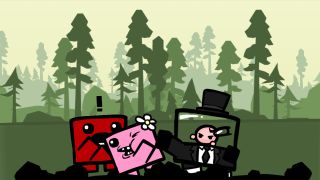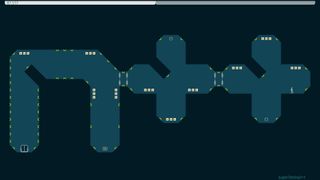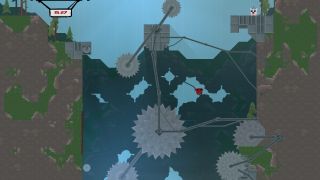RIP Flash games: you gave us a whole new way of thinking about difficulty
It may no longer power the internet, but Adobe Flash changed PC gaming forever.

Farewell, Flash—we knew ye a little too long, to be perfectly honest. When Adobe finally ends support for the browser plugin at the end of this month, and blocks content from running in Flash Player in January, security experts will breathe a sigh of relief. Over the years, the platform has become notorious for its vulnerability to malware. It’s fair to say that lately, Flash has had the reputation of a stuck window through which the Manson family regularly clambered to do their work.
When HTML5 came along, offering similar tools without the risk, web developers happily hopped over, and prompts to install Flash in order to access a site became less and less frequent. But there was a time when Flash was the beating heart of the internet—and a key influence on the culture of PC games.

In the mid ‘00s, teens spent a lot of time staring blankly at Internet Explorer or, if they were cool, Firefox. Phone browsers were horrible and laggy; Twitter and Facebook didn’t exist; TikTok was conceptually beyond the ken of even our finest futurists. What we did have was MSN Messenger, a direct message platform that popularised both the use of emojis—or emoticons, as we called them back then—and staring anxiously at a box that indicated somebody was typing, and then not typing, and then typing again. It passed the days.
Flash games offered a way to fill the time between writing ‘wuu2’, and receiving the reply ‘chattin 2 u lol, wuu2’. Browser platforms like Newgrounds, Kongregate and Miniclip flourished by hosting crude 2D simulations of snooker, golf, and skateboarding, while filling the borders of the screen with advertising. Though not much to look at, these games broke through the usual barriers that keep people from gaming: expensive GPUs, big downloads, and learning how to interact with controllers.
You wouldn’t hold up many examples from the time as classics of the medium. Nor were they considered as such then. Most were throwaway timewasters, the spiritual predecessors to idle clickers. Some games, however, rose above the dross. Like those made by Edmund McMillen.
McMillen’s work was a perfect match for Flash’s subculture of animated shorts—in particular the macabre and surreal comedy of David Firth, which was also hosted by Newgrounds. While his earliest games are a catalogue of cheap shock (see Dead Baby Dressup!, 8 More Dead Baby Uses!, Dead Baby Dressup X), McMillen’s art style became increasingly distinctive, an unnerving blend of the cutesy and the bodily.

That led to the free Flash prototype of Super Meat Boy, and ultimately to The Binding of Isaac—two profoundly important early indie games. McMillen was ready for the indie boom once it came, because in Flash he’d found a refuge from the mainstream in which to hone his craft without interference, while reaching huge audiences of unconventional gamers. The same was true for other influential developers, like point-and-click adventure revivalists Amanita Design, and Super Hexagon designer Terry Cavanagh.
The biggest gaming news, reviews and hardware deals
Keep up to date with the most important stories and the best deals, as picked by the PC Gamer team.
These names are not the only way in which Flash has left a lasting legacy. It also changed the way designers approached difficulty. Flash developers were designing games for distraction, as opposed to the immersive escapism of PC and consoles. Their play sessions lasted seconds, not hours, and that context is reflected in the games—many of which are tricky challenges, quick to kill you, but with instant resets that take the sting out of failure.

Since referred to as microchallenge or masocore, it’s a paradigm that rewards players for many consecutive attempts at the same screen. The jump that initially seemed impossible could, in a matter of minutes, be overcome with ease. Soon, frustration gave way to the joy of mastery, and the pride of self-improvement.
You can see the same structure in the direct descendants of Flash’s hit games, like McMillen’s The End is Nigh, Cavanagh’s VVVVVV, Metanet’s N++, and Ubisoft’s Trials (though as a teen I personally played BMX Backflips, a Trials competitor). And the influence extends beyond the developers who were there in that first wave. Rayman Legends was the first N-like to come from a major publisher. Celeste, the celebrated platformer that turns a personal battle with anxiety into a literal mountain climb, is recognisable as a close relative of Super Meat Boy—albeit one with accessibility options befitting a modern game. And Ghostrunner, despite its overtones of Doom and Mirror’s Edge, has the one-hit-kills and generous checkpointing that mark out a microchallenge game.

To my mind, Flash games were responsible for the greatest innovation in game difficulty of the 21st century. At least until FromSoftware came along, instilling Dark Souls with the heavy sense of carrying your progress like a lead weight, praying it isn’t yanked from your limp hands.
The internet is no longer built on Flash, and we can be grateful for that. But we can be grateful, too, for the strange, squishy platformers and masochistic sports games the plugin gave us at its height. We’re still playing them, in one form or another.
Most Popular





